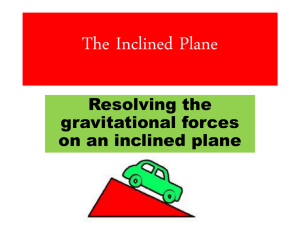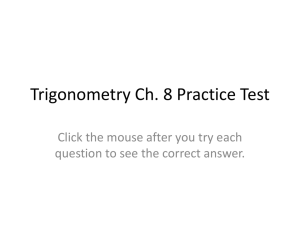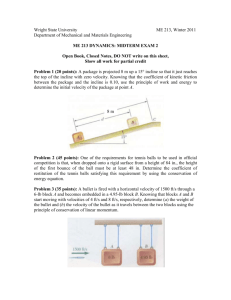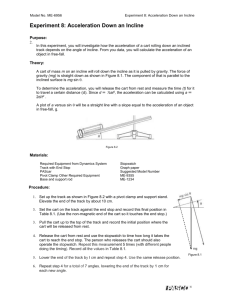Weight Components on an Inclined Plane
advertisement
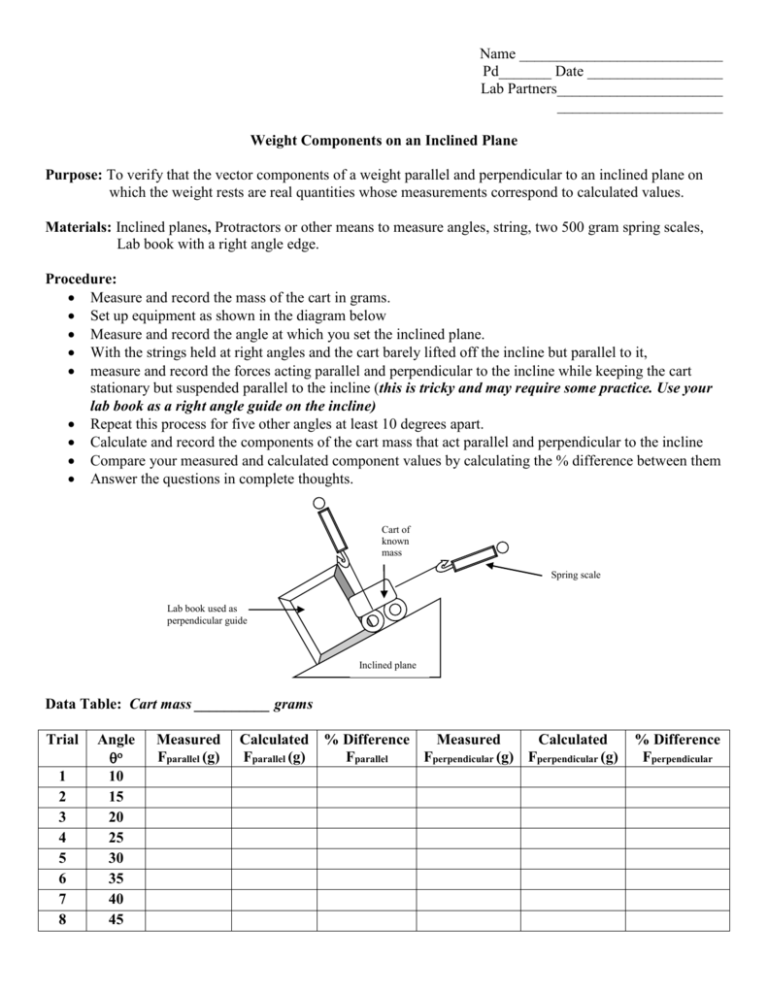
Name ___________________________ Pd_______ Date __________________ Lab Partners______________________ ______________________ Weight Components on an Inclined Plane Purpose: To verify that the vector components of a weight parallel and perpendicular to an inclined plane on which the weight rests are real quantities whose measurements correspond to calculated values. Materials: Inclined planes, Protractors or other means to measure angles, string, two 500 gram spring scales, Lab book with a right angle edge. Procedure: Measure and record the mass of the cart in grams. Set up equipment as shown in the diagram below Measure and record the angle at which you set the inclined plane. With the strings held at right angles and the cart barely lifted off the incline but parallel to it, measure and record the forces acting parallel and perpendicular to the incline while keeping the cart stationary but suspended parallel to the incline (this is tricky and may require some practice. Use your lab book as a right angle guide on the incline) Repeat this process for five other angles at least 10 degrees apart. Calculate and record the components of the cart mass that act parallel and perpendicular to the incline Compare your measured and calculated component values by calculating the % difference between them Answer the questions in complete thoughts. Cart of known mass Spring scale Lab book used as perpendicular guide Inclined plane Data Table: Cart mass __________ grams Trial 1 2 3 4 5 6 7 8 Angle 10 15 20 25 30 35 40 45 Measured Fparallel (g) Calculated % Difference Measured Calculated Fparallel (g) Fparallel Fperpendicular (g) Fperpendicular (g) % Difference Fperpendicular Sample Calculations: Quantity Fparallel Formula Used Substitution Answer with Units Fperpendicular % Error Fparallel % Error Fperpendicular Questions: Directions: Please answer each of the following questions completely, making sure to justify your answer 1. What is your average percent error for the Fparallel components? ________ 2. What trend do you notice for the values of Fll as the angle of inclination rises? 3. If the string is not held exactly parallel to the incline at a slightly too high angle, what happens to the force you measure for Fparallel? Explain. 4. If the string is not held exactly parallel to the incline at a slightly too low angle, what happens to the force you measure for Fparallel? Explain. 5. Suppose in your third trial you mis-read the gram force scale by 10 grams at the angle for that trial from the horizontal.What new % difference does this give for the calculated Fll component, and how much CHANGE in percent difference does this make? Show the calculation. 6. Using your _______(will be assigned) trial results for comparison, show the calculation of percent error and the CHANGE in percent difference that would result for the value of Fll if you held the string that should be parallel to the incline up too far by 2 degrees. String held too far up 2o String held parallel to incline 7. What is your average percent error for the F components? ________ 8. What trend do you notice for the values of F as the angle of inclination rises? 9. If the string being held parallel to the incline is at a slightly too high angle, what happens to the force you measure for F ? Explain. 10. If the string being held parallel to the incline is at a slightly too low angle, what happens to the force you measure for F ? Explain. 11. The spring scales used for this lab had divisions of 10 grams. Suppose you mis-read the scale by 10 grams. Calculate the percent error this would give you and the CHANGE in percent difference for your value of calculated F you obtained for your third trial. 12. Sum up the percent error CHANGES (not the percent errors) you found in questions 5 and 6. How much of your original percent differences for the parallel components does this sum account for? 13. Sum up the percent error CHANGES (not the percent errors) you found in question 11. How much of your original percent differences for the perpendicular components does this amount account for? 14. According to your lab results, are vector components real? Justify your answer.
